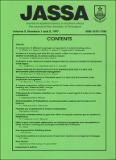| dc.contributor.author | Nheta, C. | |
| dc.contributor.author | Topps, J.H. | |
| dc.contributor.author | Dzama, K. | |
| dc.contributor.author | Kusina, J. | |
| dc.contributor.author | Foggin, C. | |
| dc.contributor.author | Honeywell, J. | |
| dc.coverage.spatial | Zimbabwe. | en |
| dc.date.accessioned | 2016-03-08T16:12:35Z | |
| dc.date.available | 2016-03-08T16:12:35Z | |
| dc.date.issued | 1997 | |
| dc.identifier.citation | Nheta, C. et al., (1997) A comparison of different roughages as ingredients in Ostrich finishing rations, Journal of Applied Science in Southern Africa, vol. 3, nos. 1/2, pp. 1-9. Harare: UZ Publications | en |
| dc.identifier.issn | 1019-7788 | |
| dc.identifier.uri | https://opendocs.ids.ac.uk/opendocs/handle/20.500.12413/9912 | |
| dc.description | A JASSA study on animal feed nutrition in the stock-feed ostrich rearing agricultural industry of Zimbabwe. | en |
| dc.description.abstract | The inclusion of poor quality roughage in diets for growing ostriches (Struthio camelus var. domesticus) at an age when the gut is fully functional will cheapen the diet, provide energy as volatile fatty acids (VFA) and help to sustain growth rate with less likelihood of excess deposition of body fat. In this trial, three sources of roughage were compared in growing ostriches by measuring growth rate, body fat deposition and digestibility of the diets. Thirty two ostriches aged on average 7.4 + 0.13 months were randomly allocated to four dietary treatments (a control diet (CN) of concentrate and a legume hay, and concentrate with either veld hay (VH), Katambora Rhodes grass hay (RG) or maize stover (MS)) resulting in eight birds being allotted to each treatment to measure growth rate, metatarsal length, fat deposition and digestibility of the diets. The following mean initial liveweight per group were obtained; CN (62.6 ± 12.62, n=7), VH (58.8 ± 12.34, n=7), RG (61.6 ± 12.63, n=7) and MS (58.3 ± 8.14, n=7). There were no treatment differences (p>0.05) on growth rate measured by increment of metatarsal length between the four treatments. The quantities of backfat and chestfat, and backfat and abdominal fat thickness, were greater (p<0.05) in birds given either veld hay or Rhodes grass hay compared to those on the control or maize stover diet. There was no difference (p>0.05) in backfat deposition in between birds fed on the control and maize stover diets. There was no difference (p>0.05) in backfat deposition between birds fed on either veld hay or Rhodes grass hay diets. Crude protein appeared to be equally well digested irrespective of the source of the roughage component. The digestibility of the neutral detergent fibre was greater (p<0.05) for the maize stover and Katambora Rhodes grass hay diet than for the veld hay and control diet. | en |
| dc.language.iso | en | en |
| dc.publisher | University of Zimbabwe (UZ) Publications | en |
| dc.rights.uri | http://creativecommons.org/licenses/by-nc-nd/3.0/ | en |
| dc.subject | Agriculture | en |
| dc.subject | Nutrition | en |
| dc.subject | Science and Society | en |
| dc.title | A comparison of different roughages as ingredients in Ostrich finishing rations | en |
| dc.type | Article | en |
| dc.rights.holder | University of Zimbabwe (UZ) | en |


